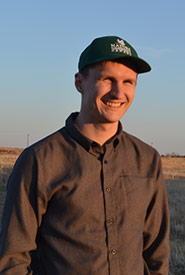10 facts about Saskatchewan's species
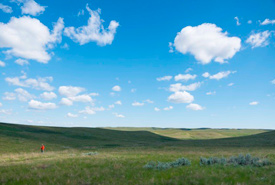
Wideview, SK (Photo by Bill Armstong)
Located right in the middle of Canada, Saskatchewan is full of amazing species and ecosystems. To celebrate the prairie province, here are 10 amazing facts about species that you can find in Saskatchewan.
1. Prairie aerial acrobatics
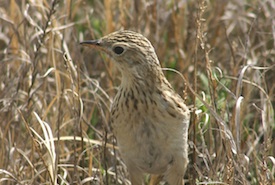
Sprague's pipit, Shoe Lake West, SK (Photo by Stephen Davis)
Songbirds usually find the highest spot they can to sing. Males sing to attract females’ attention, but also warn other male birds to stay out of their territory. The Sprague’s pipit is a prairie bird, meaning that it has no trees or other high points to sing from. Instead it flies to a great height, sometimes hundreds of feet in the air, and drifts in the wind to send out its song. It is the finale to the Sprague’s pipit’s song that has made it famous, though. After singing in the air for between 40 minutes to an hour, the Sprague’s pipit plummets back to the ground before quickly pulling up right before it hits the prairie grasses.
You can find Sprague’s pipit on the Nature Conservancy of Canada’s (NCC’s) Buffalo Valley property in Saskatchewan.
2. Life gets better when chewed
The large Indian bread root plant can reproduce better if it has been chewed by a bison. The tough outer seed coat of the plant is broken down by the bison’s chewing and digestive system, which allows seeds to be more easily spread after it has been passed through the animal’s gut.
You can find plains bison and large Indian bread root on NCC’s Old Man on His Back Prairie Heritage and Conservation Area.
3. Mother of many
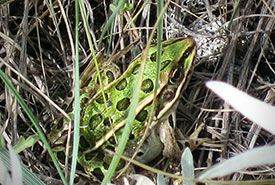
Northern leopard frog (Photo by Sarah Ludlow/NCC)
Frogs, like the northern leopard frog, never drink water! Instead, they absorb it through their skin.
Northern leopard frogs have 6,500 tadpoles at a time. And you thought having twins was a lot of work? Only a small number of these tadpoles ever make it to maturity. With a shrinking habitat range, western boreal/prairie populations of the northern leopard frogs have been dwindling in population since the 1970s. That is why it is exciting to find them on an NCC property.
You can find northern leopard frogs on NCC’s Pasqua Lake property in Saskatchewan.
4. The world's fastest animal
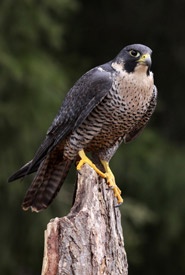
Peregrine falcon (Photo by Chris Hill)
The peregrine falcon is the world’s fastest animal. It can reach speeds of up to 390 kilometres per hour while hunting. The peregrine falcon almost exclusively hunts other birds, which is why it has to be so fast. Its primary hunting strategy is called the “stoop,” and involves diving from great heights and knocking the wing of its prey. This allows the peregrine falcon to knock its prey down, making it easier to grab onto, but it also allows it to stop itself before hitting the ground at great speed.
Peregrine falcons can be found on NCC’s Reed Lake property.
5. Moose on the loose
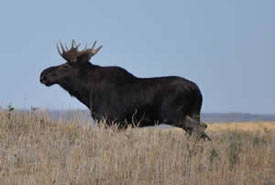
Moose in northern Saskatchewan (Photo by ehCanadaTravel.com)
Speaking of speedy animals, you probably don’t think of moose when you think of nature’s fastest creatures. It might surprise you to learn, then, that moose can run nearly 60 kilometres per hour. Compared to humans, who, at our very fastest, can only run 45 kilometres per hour, moose are pretty quick.
You can often see moose on NCC’s Nebo property in Saskatchewan.
6. A choking mess
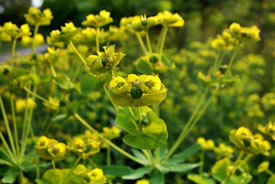
Leafy spurge (Photo by Ed L/pawpaw67)
You can find leafy spurge all over the Saskatchewan prairie. Unfortunately, that doesn’t make NCC staff very happy. Leafy spurge is a species native to Europe that has invaded Saskatchewan. The plant chokes out other species and creates a sap that can irritate livestock and bison.
You can find leafy spurge from BC to PEI and in Yukon Territory as well. NCC staff are working hard to remove it from our Big Valley property this summer. After its removal, other species will have a better chance to grow.
7. Grasses of Saskatchewan
Needle and thread grass is Saskatchewan's provincial grass and get its name from its seed. The seed has a sharp tip that can spear into passing animals fur (or your socks if you aren't careful), which will carry the it to a new area. The sharp end will also spear into the ground which will help plant the seed.
You can find the needle and thread grass at NCC’s Wideview property in Saskatchewan.
8. A common sight in Saskatchewan
Trembling aspen is North America's most common tree. Found across Northern Saskatchewan it is a dioecious plant, meaning that it has male and female plants. The female tree produces fruit when the flowers are fertilized by a male tree.
You can find trembling aspen at NCC’s Meeting Lake property in Saskatchewan.
9. Blind as a bat? Not so.
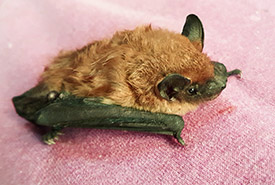
A big brown bat "hanging out." Often when found outside, big brown bats sit in this position on the side of a building, tree or (ideally not) on the ground. (Photo by Sarah Ludlow/NCC)
Contrary to popular belief, bats are not blind. They use echolocation to navigate in the dark, but they still have good vision. Fruit bats tend to use their eyesight to hunt, while insect-eating bats tend to use echolocation more often. Perhaps the blind bat myth started because there are no fruit bats in Canada, but even bats that use echolocation can see.
At dusk you can see big brown bats flying around NCC’s Edenwold property in Saskatchewan.
10. Ferocious jaws
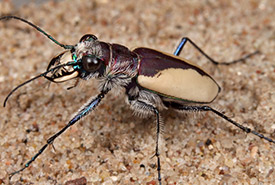
Gibson's big sand tiger beetle (Photo by Ted MacRae)
Gibson's big sand tiger beetles are one of the largest tiger beetles in North America, and are predators in both the adult and larval stages. During the larval stage, they live in a vertical tunnel, in sandy regions with a small pit-like opening from where they can ambush ants and other small arthropods.
Gibson’s big sand tiger beetle is listed as a threatened species under the Species at Risk Act. They need open sandy areas but these rare habitats are declining. So NCC was very excited to recently find them on our Dundurn property in Saskatchewan. We hope to find them on other Saskatchewan properties in the future.
The Conservation Internship Program is funded in part by the Government of Canada’s Summer Work Experience program.

